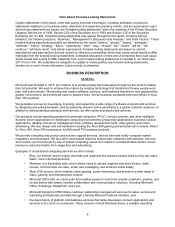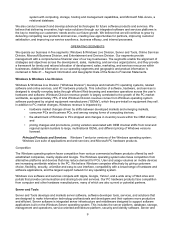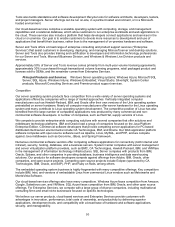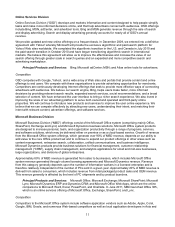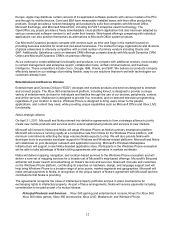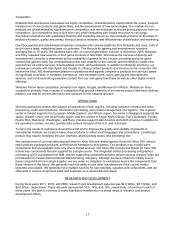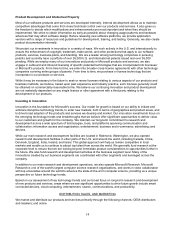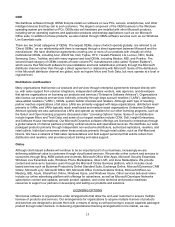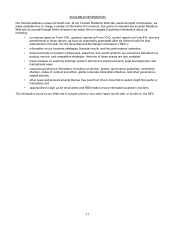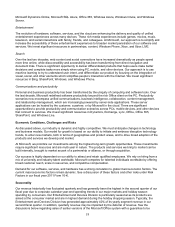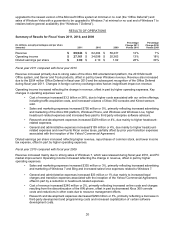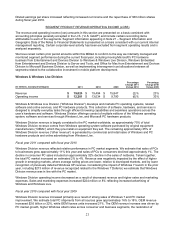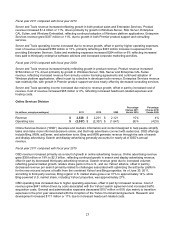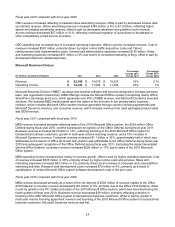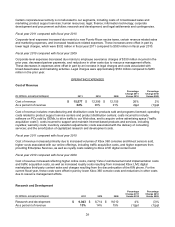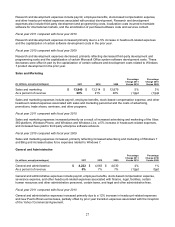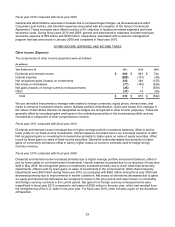Microsoft 2011 Annual Report Download - page 18
Download and view the complete annual report
Please find page 18 of the 2011 Microsoft annual report below. You can navigate through the pages in the report by either clicking on the pages listed below, or by using the keyword search tool below to find specific information within the annual report.
18
MANAGEMENT’S DISCUSSION AND ANALYSIS OF FINANCIAL CONDITION AND
RESULTS OF OPERATIONS
The following Management’s Discussion and Analysis (“MD&A”) is intended to help the reader understand the
results of operations and financial condition of Microsoft Corporation. MD&A is provided as a supplement to, and
should be read in conjunction with, our financial statements and the accompanying Notes to Financial
Statements.
OVERVIEW AND OUTLOOK
Microsoft is a technology leader focused on helping people and businesses throughout the world realize their full
potential. We create technology that transforms the way people work, play and communicate across a wide range
of computing devices.
We generate revenue by developing, licensing, and supporting a wide range of software products and services,
by designing and selling hardware, and by delivering relevant online advertising to a global customer audience.
Our most significant expenses are related to compensating employees, designing, manufacturing, marketing and
selling our products and services, and income taxes.
Industry Trends
Our industry is dynamic and highly competitive, with frequent changes in both technologies and business models.
Each industry shift is an opportunity to conceive new products, new technologies, or new ideas which can further
transform the industry and our business. At Microsoft, we push the boundaries of what is possible through a broad
set of research and technology innovations that seek to anticipate the changing demands of customers, industry
trends, and competitive forces.
Key Opportunities and Investments
Based on our assessment of key technology trends and our broad focus on long-term research and development
of new products and services, we see significant opportunities to drive future growth.
Smart connected devices
The price per unit of processing, storage, and networks continues to decline while at the same time devices
increase in capability. This ongoing trend is increasing the capabilities of PCs, mobile, and other devices powered
by rich software platforms and applications. At the same time, the information and services people use
increasingly span multiple devices. User experiences will be transformed by the adoption of cloud computing
when brought together with the richness of smart, connected devices. Microsoft is delivering experiences that
seamlessly connect PCs and mobile and other devices through the cloud. We are devoting significant resources
to consumer cloud offerings like Bing, Windows Live, and Xbox LIVE. Our software and hardware platform
investments can be seen in products like Kinect, Windows, Windows Azure, Windows Phone, Windows Server,
and Xbox.
Cloud computing transforming the data center and information technology
Cloud-based solutions provide customers with software, services and content over the Internet by way of shared
computing resources located in centralized data centers. Computing is undergoing a long-term shift from
client/server to the cloud, a shift similar in importance and impact to the transition from mainframe to client/server.
The shift to the cloud is driven by three important economies of scale: larger data centers can deploy
computational resources at significantly lower cost than smaller ones; larger data centers include diverse
customer, geographic, and application demand patterns which improve the utilization of computing, storage, and
network resources; and multi-tenancy lowers application maintenance labor costs for large public clouds. As a
result of the improved economics, the cloud offers unique levels of elasticity and agility that will enable new
solutions and applications. For businesses of all sizes, the cloud creates the opportunity to focus more on
innovation while leaving non-differentiating activities to reliable and cost-effective providers. For most businesses,
the first step in achieving cloud economics is the adoption of virtualization in their data center. We are devoting
significant resources to developing cloud infrastructure, platforms, and applications including offerings such as


